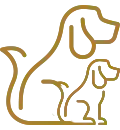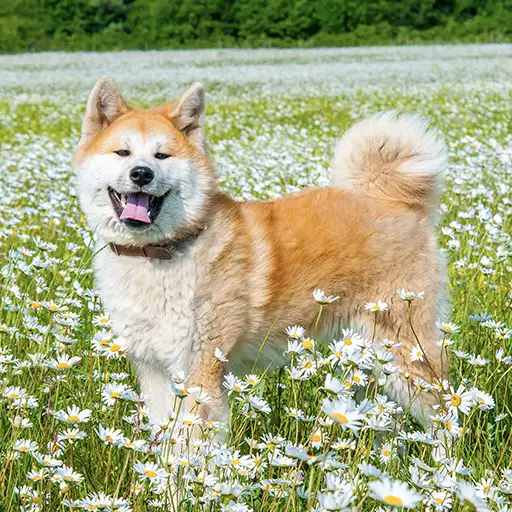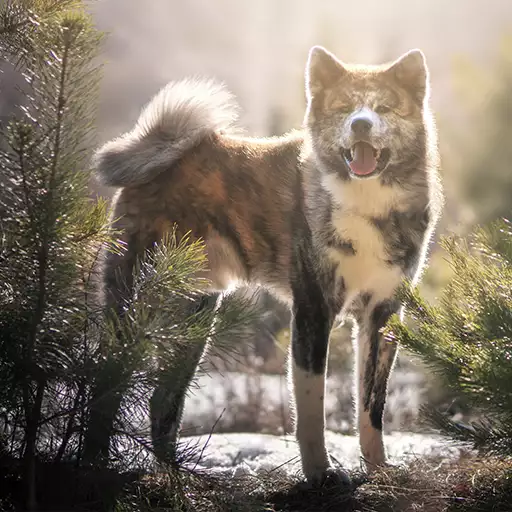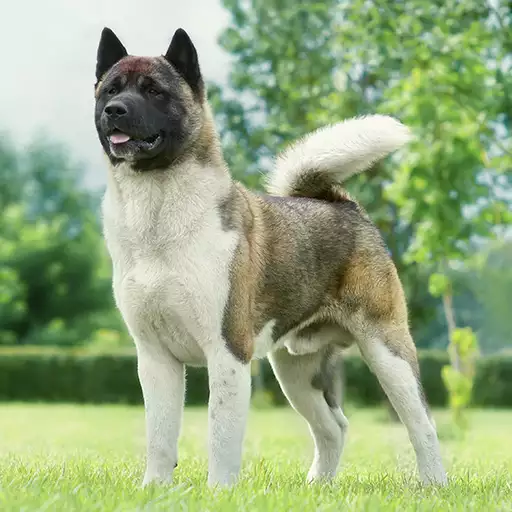The Akita
Courageous, dignified and deeply loyal, Akitas were first developed in Japan and then adapted by Americans. The Akita is a large, powerful dog with a great deal of physical substance. The dog’s tail curls over the back, which is one of the hallmarks of the breed. Aloof with strangers, the Akita dog breed is affectionate with their family.

Akita Dog Breed Information

Life Span
10-14 Years

Height
24-28 Inches

Weight
70-130 Lbs

AKC Breed Group
Working

Size
Large Breed

Common Colors
Black, Brown Brindle, Fawn, Red
Quick Guide
- The Akita
- Akita Dog Breed Information
- History of the Akita
- Akita FAQs
- Send Us Your Akita Pictures!
- More About Akitas
- The Akita Pitbull Mix – An Overview Of This Unique Cross Breed
- Akita vs Shiba Inu – Comparing These Japanese Dog Breeds
- 6 Best Dog Shampoos & Conditioners For Akitas in 2025
- 14 Best Dog Foods for Akitas: Our 2025 In-Depth Feeding Guide
- 7 Best Dog Harnesses for Akitas in 2025
History of the Akita
The Akita has a rather long and complex history. Oral and written Japanese history report that the Akita is descended from the Matagi dog (a dog for hunting, bear hunting, and deer hunting). This was an ancient native dog and it makes the Akita’s lineage one of the oldest of modern breeds.
The Akita today was mostly developed from dogs in the northern part of the island of Honshu – in the Akita prefecture, which provided the breed with its name. The ancestors of the Akita tracked large game and held it at bay until the hunter arrived to kill it. In the early 20th century Akitas were also crossed with European dogs such as the Mastiff, the Saint Bernard, the Great Dane, and the Tosa Inu because there was some interest in developing a fighting dog.
During World War II Akitas were crossed with German Shepherd Dogs in an attempt to save them due to orders that non-military dogs had to be culled.
The Akita became well-known to the outside world thanks to the story of Hachiko, the most famous and revered Akita of all time. Born in 1923, Hachiko was owned by a professor in Tokyo. The professor lived near a train station in a suburb of Tokyo and commuted to the city to work every day. Hachiko would accompany the professor to and from the station each day.
In May 1925, when Hachiko was just 18 months old, the professor suffered a fatal brain hemorrhage while at work. Hachiko waited for the professor to arrive on the train that afternoon and he continued to travel back and forth to the train station, waiting for his owner, for the next nine years. He let the professor’s family take care of him but he refused to give up his vigil for the professor.
Hachiko was known around the world by the time a bronze statue was dedicated to him in the train station in 1934, shortly before he died. The statue was melted down for armaments during the war but it was erected again after the war. Every year on April 8 Hachiko’s loyalty and devotion to the professor are honored at the train station with a solemn ceremony. Hachiko’s fidelity became a national symbol of loyalty.
The Akita breed, along with six other Japanese breeds, is considered to be a Japanese Natural Monument. In the 1930s the first Japanese breed standard for Akitas was created. In 1937 Helen Keller traveled to Japan and was presented with the first two Akitas to come to the United States.
In Japan the breed was nearly brought to extinction during World War II. Some dogs were killed so they could feed hungry people and their fur was used to clothe people who were cold. Eventually the government ordered the remaining dogs to be killed to prevent the spread of disease.
Some owners turned their dogs loose in the mountains to save them. There the dogs interbred again with the original dogs, the Matagi.
Other people interbred Akitas and German Shepherds so they could claim the dogs were military dogs. Thanks to the efforts of a few dedicated people, the breed was able to survive.
The breed began to thrive once again during the Occupation that followed World War II. The breed began to be bred for a standardized appearance. Breed numbers grew. Many U.S. servicemen fell in love with the breed at this time and brought dogs back to the U.S.
Following World War II the Akita began to split into Japanese and American types. American soldiers in Japan seemed to prefer Akitas that were larger and more bear-like or influenced by the German Shepherd than the smaller, fox-like Akita Inu dogs preferred by the Japanese.
While Japanese fanciers focused on restoring the Akita as a natural monument or work of art, the Americans preferred the larger, bigger boned, more intimidating dogs. Today both types share a common ancestry but there are noticeable differences in them.
American style Akitas are accepted in any colors while Japanese Akitas are only permitted to be fawn, sesame, red, white, or brindle.
American Akitas can also have black masks or pinto coloration; these markings are not allowed in Japanese dogs.
Japanese Akitas are usually lighter with a finer, more fox-like head; while American Akitas are typically heavier, with larger bones and a more bear-like head.
The Akita was recognized by the AKC in 1955 but is was placed in the Miscellaneous class where it remained until 1972 until there were enough fanciers and dogs in the U.S. to support the breed.
oday the breed is in the Working class and it is the 47th most popular breed in the U.S. In some countries the two styles of Akita are considered separate breeds today (American Akita and Japanese Akita Inu) but in the U.S. and Canada they are still considered one breed with differences in type.
Akita Health-Related Issues
The Akita Club of America recommends the following health tests for breeders who are considering breeding their Akitas (note that some of the tests below are optional):
Hip Dysplasia
- OFA Evaluation – OR
- PennHIP Evaluation
Eye Examination by a boarded ACVO Ophthalmologist each year until 6, thereafter every 2 years
- Results registered with OFA – OR
- Results registered with CERF
Autoimmune thyroiditis
- OFA evaluation from an approved laboratory
Elbow Dysplasia (Optional)
- OFA evaluation
Patellar Luxation (Optional)
- OFA evaluation
The Akita can be subject to a number of autoimmune diseases including Vogt-Koyanagi-Harada syndrome or Uveo-Dermatologic syndrome which affects the skin and eyes. They can also be affected by autoimmune hemolytic anemia – a blood disorder. Sebaceous Adenitis is an autoimmune skin problem that seems to occur as a result of autosomal recessive genes.
Pemphigus Foliaceus is another autoimmune skin problem that is thought to be genetic. Systemic Lupus Erythematosus or SLE or Lupus is an autoimmune systemic disease or autoimmune disease affecting connective tissue that can be found in any part of the body.
Akitas can also have health problems with some immune-mediated endocrine diseases. These illnesses are affected by the body’s hormones. They include Addison’s Disease or hypoadrenocorticism which affects the adrenal glands; Cushing’s Syndrome or hyperadrenocorticism, which also affects the adrenal glands. It can be caused by long-term exposure to lots of glucocorticosteroids – sometimes given in medications.
Diabetes mellitus is another kind of immune-mediated endocrine disease, also known as Diabetes 1. It affects the dog’s pancreas. Akitas can also be affected by hypothyroidism, which affects the thyroid gland.
Other conditions that can affect Akitas (and many other dogs) include bloat, progressive retinal atrophy and some other eye conditions such as glaucoma, hip and elbow dysplasia, and Von Willebrand’s Disease – a bleeding disording with some similarities to hemophilia.
As a breed, Akitas have a particular sensitivity to certain vaccinations, drugs, anesthetics, insecticides, and other medications. This is documented in veterinary literature but you should remind your veterinarian when he sees your dog.
Akitas, like many Asian breeds, have more potassium in their red blood cells than other dogs. For this reason, when their blood is drawn they can exhibit Pseudohyperkalemia. This means that their blood results can give a false reading for being high in potassium or for the condition hyperkalemia. You may need to remind your veterinarian or vet techs that this condition is common and even normal for Akitas.
If you are thinking of getting an Akita you should talk to the breeder about the health issued described here. Many dogs will be perfectly healthy and breeders strive to produce healthy puppies but you should discuss health guarantees and understand the breeder’s philosophy toward health matters. The Akita Club of America supports research into many of these conditions and progress is being made.
Akita Temperament
As reflected in its past, the Akita is an intensely loyal, courageous, and dignified breed. They tend to be territorial and protective of their homes and you can expect an Akita to be reserved with strangers. However, they are affectionate and loving toward family members. Akitas do not usually get along well with other dogs of the same sex. In fact, the breed has not been kept together in packs, historically. They are usually more comfortable in a one-dog family or with just one other dog. They tend to be socially dominant with other dogs so they are not usually recommended for families that have multiple dogs.
Because of their large size and strength, the Akita is not usually recommended for the first-time dog owner. They can also have a dominating personality that can be hard for the novice owner to control.
They can be quite independent in nature at times. In some countries they are considered to be a “dangerous dog” under certain legislation, but this is probably due more to their size and powerful appearance than any particular history or actions of the breed.
Dogs with the proper Akita temperament may be reserved with strangers but they should not be threatening. However, they may be suitably protective of their family when necessary. Unless defending their home, the Akita is generally calm and gentle.
Akitas are typically good with children and the breed is said to have an affinity for them. However, you should always take appropriate precautions with children and dogs.
Akitas are known for being almost cat-like in their cleanliness. They enjoy self-grooming and prefer to keep themselves clean. They like to wash their faces after they eat and, if there is another dog in the house, they may wash that dog, too.
As you might guess, socialization from a young age is recommended for Akitas so they are not overly reserved with strangers. Socialization can also help them be more accepting of other dogs and pets. It is usually recommended that owners do not take Akitas to places like off-leash dog parks since they are not always friendly toward strange dogs unless they are very well-socialized.
Akita Grooming
Male Akitas typically stand 26-28 inches tall at the withers and weigh between 100 and 130 pounds. Female Akitas usually stand 24-26 inches tall at the withers and weigh between 70 and 100 pounds. The Japanese style Akita is slightly smaller and weighs a little less.
Considered a spitz breed, the Akita has a thick double coat but there are two coat types – the standard coat type and the long coat type. Long coats are considered faults in the show ring but they exist in the breed. They are called Moku. The coat is 3-4 inches long and softer than the typical coat. The standard coat is most often seen.
Despite their thick double coat, the Akita is considered to require little grooming maintenance. Akitas do shed a great deal and may have especially heavy moults 2-3 times per year. If you brush your dog daily it will help reduce problems with shedding. Other than brushing, not much else is required for grooming. Baths do not need to be frequent and the breed tends to keep itself especially clean.
Trim nails regularly and clean ears often. Brush your dog’s teeth on a regular basis.
Akita Fun Facts
- Hachiko’s story was made into a Disney film – Hachi: A Dog’s Tale – starring Richard Gere. They definitely took some liberties with the story, but it’s still a touching film with an Akita star.
- Akitas today make great therapy dogs. They also compete in events such as obedience trials, tracking, agility, weight pulls, and Schutzhund, as well as other dog events.
- Seven dog breeds, including the Akita, are considered “Natural Monuments” in Japan. The law allows for the protection of natural monuments as cultural properties and includes historic locations, places of scientific value, places of scenic beauty, geological and mineral formations, as well as certain animals and plants.
Common Akita Mixes
As a very large breed dog, Akitas are not among the most common dogs used in designer mixes. Here are some of the Akita mixes we found online:
- Boxita
- Bullkita
- Golden Akita
- Huskita
- Labrakita
- Nekita
- Pookita
- Shepkita
Akita FAQs
What is an Akita’s Life Expectancy?
According to the 2004 breed health study conducted by the Kennel Club in the UK, the median age at death for the Akita was 9 years and 11 months. The most common causes of death for dogs in the survey were cancer (32.1 percent), cardiac (14.3 percent) and gastrointestinal (14.3 percent – includes bloat), In the United States, Akitas are commonly reported to have an average lifespan of 10 to 12 years. It is not uncommon for very large breeds to have a somewhat shorter lifespan than small and medium-sized dogs.
Is the Akita easy to train?
Yes and no. Akitas are very clean, even fastidious dogs. They don’t like to soil their sleeping area of make a mess in the house so they are usually easy to house train. However, obedience training can be more difficult. Akitas are intelligent dogs but they are independent and dignified. You have to treat them with respect when training them. Use positive, gentle methods, but be firm. Akitas are not usually recommended for first-time owners because they can have a dominating personality.
Do Akitas shed a lot of hair?
Yes, Akitas do shed a lot. You should brush your Akita every day to help reduce the amount of hair that drops out. Along with regular shedding, you can expect two or three large sheds per year when your Akita blows his coat.
Do Akitas make good apartment pets?
Akitas are very large and they do require regular daily exercise but they are not especially active in the house. They are docile and loving with their family. If you have a small apartment you may find that an Akita takes up a lot of space. However, you could probably keep an Akita in an apartment as long as you made sure that he got enough daily exercise.
Are Akitas good with children?
Akitas generally like children and enjoy playing with them. They won’t be injured if a toddler trips over the dog. Many people recommend a very large dog for families with small children because big dogs are often slower to react and they are less likely to be hurt if a child is playing with the dog.
It’s always important to teach all children how to play gently with a dog so they don’t pull on tails and ears or do things to provoke a dog into biting. Thousands of children are bitten by dogs every year and most bites could be avoided with supervision and teaching children how to act around dogs.
What Do Akitas Eat?
Like other large-breed dogs, Akitas do well with a protein-rich diet. It’s important to maintain a strict feeding regimen as puppies so that growth occurs evenly over time.
“Fresh is best” when feeding your Akita. Yes, human-grade dog food can be costly, but it’s ultimately the best option. For a more affordable choice, look for dry foods with real meats named in the first few ingredients on the label.
















